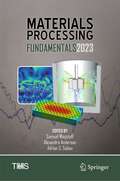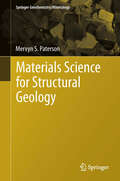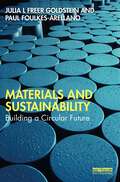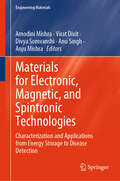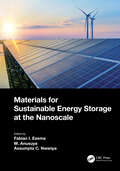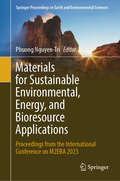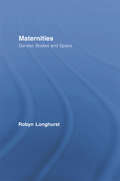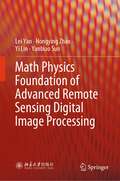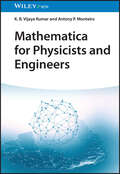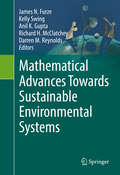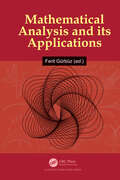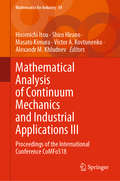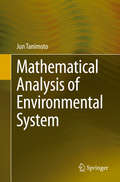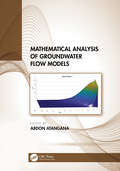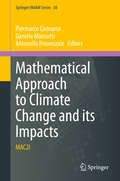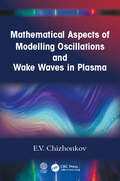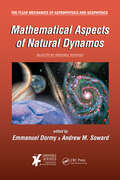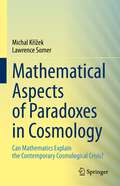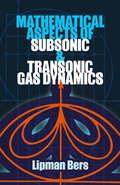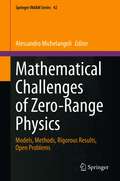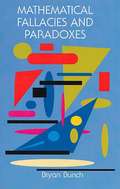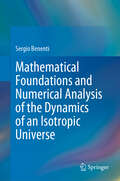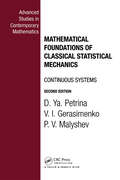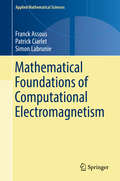- Table View
- List View
Materials Processing Fundamentals 2023 (The Minerals, Metals & Materials Series)
by Adrian S. Sabau Samuel Wagstaff Alexandra AndersonThis volume covers various aspects of the fundamentals, synthesis, analysis, design, monitoring, and control of metals, materials, and metallurgical processes and phenomena. Topics represented include but are not limited to:• Use of artificial intelligence or big data in the control or optimization of industrial processes • Modelling or optimization of recycle streams and scrap loops • Measurement and control in hostile environments • Modeling transport phenomena in materials processing and metallurgical processes involving iron, steel, nonferrous metals, and composites • Thermodynamics, kinetics, and physical chemistry of materials processes and modelling thereof
Materials Science for Structural Geology
by Mervyn S. PatersonThis book sets out the basic materials science needed for understanding the plastic deformation of rocks and minerals. Although at atmospheric pressure or at relatively low environmental pressures, these materials tend to be brittle, that is, to fracture with little prior plastic deformation when non-hydrostatically stressed, they can undergo substantial permanent strain when stressed under environmental conditions of high confining pressure and high temperature, such as occur geologically in the Earth's crust and upper mantle. Thus the plastic deformation of rocks and minerals is of fundamental interest in structural geology and geodynamics. In mountain-building processes and during convective stirring in the Earth's mantle, rocks can undergo very large amounts of plastic flow, accompanied by substantial changes in microstructure. These changes in microstructure remain in the rocks as evidence of the past deformation history. There are a number of types of physical processes whereby rock and minerals can undergo deformation under geological conditions. The physics of these processes is set out in this book.
Materials and Sustainability: Building a Circular Future
by Julia L Goldstein Paul Foulkes-ArellanoThis book examines sustainable manufacturing, from the extraction of materials to processing, use, and disposal, and argues that significant changes in all of the above are needed for the world to progress toward a more circular economy.Materials and processing methods are usually chosen with performance as the key metric. Why has our society embraced plastics? Because they work. In most cases, they are lighter, easier to manufacture, and less expensive than the metal, wood, glass, or stone they have replaced. Why do industrial manufacturers use toxic chemicals? Because they are effective, but the unintended consequences may be severe. By learning how various materials are made and what happens when they are recycled, readers will better understand the value of materials and the challenges that manufacturers face when trying to make their facilities and products less toxic and less wasteful. The three chapters in Part I provide essential background about materials in the circular economy, chemicals, and waste. Part II delves into specific materials. It includes chapters on plastics, metals, wood and paper products, glass, and novel materials. Part III covers recycling and manufacturing processes, and Part IV delves into practical considerations, including the effect of regulations, concluding with a chapter that helps readers translate the information presented into action. Interviews with industry experts round out the chapters and offer valuable insights.Materials and Sustainability is a must-read for business professionals who are serious about making their companies as environmentally responsible as possible and for business and engineering students who want to begin their careers with practical knowledge about materials and their impacts.
Materials for Electronic, Magnetic, and Spintronic Technologies: Characterization and Applications from Energy Storage to Disease Detection (Engineering Materials)
by Amodini Mishra Virat Dixit Divya Somvanshi Anu Singh Anju MishraThis book consolidates the collective contributions of various authors, presenting a diverse array of materials for systematic property assessment and their subsequent application in electronic, magnetic, and spintronic technologies. Encompassing pure and modified polymers, metals, and semiconductors, the book elucidates the magnetic, photocatalytic, thermal, electrochemical, and other salient characteristics inherent in these materials. Delving into a broad spectrum of applications such as energy storage, environmental remediation (water purification), and biomedical (drug administration), the book carefully examines these materials in the context of their distinctive attributes. By elucidating the correlation between a material's functionality and its physical properties, this work offers a lucid and accessible presentation that facilitates an understanding of how these materials can be judiciously employed for specific purposes. Designed for researchers, graduate students, educators, engineers, industry researchers, and other informed members of the public, the comprehensive coverage of this book renders it an indispensable tool in the realm of materials science and technology. Through its meticulous exploration of various materials and their applications, this work stands as a valuable resource for those seeking a profound understanding of the intricate interplay between material properties and their functionalities.
Materials for Sustainable Energy Storage at the Nanoscale
by Fabian I. Ezema M. Anusuya Assumpta C. NwanyaThe book Materials for Sustainable Energy Storage Devices at the Nanoscale anticipates covering all electrochemical energy storage devices such as supercapacitors, lithium-ion batteries (LIBs), and fuel cells,transformation and enhancement materials for solar cells, photocatalysis, etc. The focal objective ofthe book is to deliver stunning and current information to the materials application at nanoscale toresearchers and scientists in our contemporary time towardthe enhancement of energy conversion andstorage devices. However, the contents of the proposed book, Materials for Sustainable Energy Storageat the Nanoscale, will cover various fundamental principles and wide knowledge of different energyconversion and storage devices with respect to their advancement due to the emergence of nanoscalematerials for sustainable storage devices. This book is targeted to be award-winning as well as a referencebook for researchers and scientists working on different types of nanoscale materials-based energystorage and conversion devices. Features Comprehensive overview of energy storage devices, an important field of interest for researchers worldwide Explores the importance and growing impact of batteries and supercapacitors Emphasizes the fundamental theories, electrochemical mechanism, and its computational viewpoint and discusses recent developments in electrode designing based on nanomaterials, separators,and fabrication of advanced devices and their performances Fabian I. Ezema is a professor at the University of Nigeria, Nsukka. He earned a PhD in Physics and Astronomy from the University of Nigeria, Nsukka. His research focused on several areas of Materials Science, from synthesis and characterizations of particles and thin-film materials through chemical routes with emphasis on energy applications. For the last 15 years, he has been working on energy conversion and storage (cathodes, anodes, supercapacitors, solar cells, among others), including novel methods of synthesis, characterization and evaluation of the electrochemical and optical properties. He has published about 180 papers in various international journals and given over 50 talks at various conferences. His h-index is 21 with over 1500 citations and he has served as reviewer for several high impact journals and as an editorial board member. Dr. M.Anusuya, M.Sc., M.Phil., B.Ed., PhD is specialized in Material science, Thin Film Technology, Nano Science, and Crystallography. She is working as a Registrar of Indra Ganesan Group of Institutions, Trichy, Tamilnadu, India. Earlier to this, she served as a Vice-Principal at Trichy Engineering College, Trichy, Tamilnadu, India.. Being an administrator and teacher, with more than 25 years’ experience, for her perpetual excellence in academics she has been recognized with many awards. She has received over 45 awards in Academic and Social Activity. She has published more than 30 research papers in National and International journals, 7 chapters in edited books, 5 patents, presented 50 papers in the conferences and organized more than 200 webinars, both national and internationally. Dr Assumpta C. Nwanya is a Lecturer and a FLAIR (Future Leaders - African Independent Research) Scholar at the Department of Physics and Astronomy, University of Nigeria, Nsukka. She obtained her PhD in 2017 (University of Nigeria, Nsukka) with specialisation in the synthesis of nanostructured materials for applications in photovoltaics and electrochemical energy storage (batteries and supercapacitors) as well as for sensing. She was a Postdoctoral Fellow under the UNESCO-University of South Africa (UNISA) Africa Chair in Nanoscience and Nanotechnology (2018-2020). She is a research Affiliate with the SensorLab, University of the Western Cape Sensor Laboratories, Cape Town, South Africa. Dr Nw
Materials for Sustainable Environmental, Energy, and Bioresource Applications: Proceedings from the International Conference on M2EBA 2023 (Springer Proceedings in Earth and Environmental Sciences)
by Phuong Nguyen-TriThis proceedings book showcases the latest research and developments in materials sciences and their applications for solving environmental and energy-related challenges. The book features insightful contributions from leading researchers, academics, professionals, and students in the field, who share their expertise, experiences, and perspectives on the key issues and innovations in materials sciences and engineering. The book is helpful to those interested in environmental sustainability, energy efficiency, or bioresource utilization.
Maternities: Gender, Bodies and Space (Routledge International Studies of Women and Place)
by Robyn LonghurstOver the past decade geographers have shown a growing interest in 'the body' as an important co-ordinate of subjectivity and as a way of understanding further relationships between people, place and space. To date, however geographers have published little on what is one of, if not the, most important of all bodies - bodies that conceive, give birth and nurture other bodies. It is time that feminist, social, and cultural geographers contributed more to debates about maternal bodies. This book offers a series of windows on the ways in which maternal bodies influence, and are influenced by, social and spatial processes. Topics covered include women ‘coming out’ as pregnant at work, changing fashion for pregnant women, being disabled and pregnant, the politics of home versus hospital birth, breastfeeding practices that sit outside the norm, women who are constructed as ‘bad’ mothers, and ‘e-mums’ (mothers who go on-line).
Math Physics Foundation of Advanced Remote Sensing Digital Image Processing
by Yi Lin Lei Yan Hongying Zhao Yanbiao SunThis book focuses on the mathematical and physical foundations of remote sensing digital image processing and introduces key algorithms utilized in this area. The book fully introduces the basic mathematical and physical process of digital imaging, the basic theory and algorithm of pixel image processing, and the higher-order image processing algorithm and its application. This book skillfully and closely integrates theory, algorithms, and applications, making it simple for readers to understand and use. Researchers and students working in the fields of remote sensing, computer vision, geographic information science, electronic information, etc., can profit from this book. For their work and research in digital image processing, they can master the fundamentals of imaging and image processing techniques.
Mathematica for Physicists and Engineers
by K. B. Kumar Antony P. MonteiroMathematica for Physicists and Engineers Hands-on textbook for learning how to use Mathematica to solve real-life problems in physics and engineering Mathematica for Physicists and Engineers provides the basic concepts of Mathematica for scientists and engineers, highlights Mathematica’s several built-in functions, demonstrates mathematical concepts that can be employed to solve problems in physics and engineering, and addresses problems in basic arithmetic to more advanced topics such as quantum mechanics. The text views mathematics and physics through the eye of computer programming, fulfilling the needs of students at master’s levels and researchers from a physics and engineering background and bridging the gap between the elementary books written on Mathematica and the reference books written for advanced users. Mathematica for Physicists and Engineers contains information on: Basics to Mathematica, its nomenclature and programming language, and possibilities for graphic output Vector calculus, solving real, complex and matrix equations and systems of equations, and solving quantum mechanical problems in infinite-dimensional linear vector spaces Differential and integral calculus in one and more dimensions and the powerful but elusive Dirac Delta function Fourier and Laplace transform, two integral transformations that are instrumental in many fields of physics and engineering for the solution of ordinary and partial differential equations Serving as a complete first course in Mathematica to solve problems in science and engineering, Mathematica for Physicists and Engineers is an essential learning resource for students in physics and engineering, master’s students in material sciences, geology, biological sciences theoretical chemists. Also lecturers in these and related subjects will benefit from the book.
Mathematical Advances Towards Sustainable Environmental Systems
by Anil K. Gupta Darren M. Reynolds James N. Furze Kelly Swing Richard H. McclatcheyThis edited volume focuses on how we can protect our environment and enhance environmental sustainability when faced with changes and pressures imposed by our expansive needs. The volume unites multiple subject areas within sustainability, enabling the techniques and philosophy in the chapters to be applied to research areas in environmental science, plant sciences, energy, biodiversity and conservation. The chapters from expert contributors cover topics such as mathematical modelling tools used to monitor diversity of plant species, and the stability of ecosystem services such as biogeochemical cycling. Empirical research presented here also brings together mathematical developments in the important fields of robotics including kinematics, dynamics, path planning, control, vision, and swarmanoids. Through this book readers will also discover about rainfall-runoff modelling which will give them a better idea of the effects of climate change on the sustainability of water resources at the watershed scale. Modelling approaches will also be examined that maximize readers insights into the global problem of energy transition, i. e. the switch to an energy production system using renewable resources only. Collective and discrete insights are made to assist with synergy which should progress well beyond this book. Insight is also given to assist policy formations, development and implementations. The book has a strong multi-disciplinary nature at its core, and will appeal to both generalist readers and specialists in information technology, mathematics, biology, physics, chemistry and environmental sciences.
Mathematical Analysis and its Applications
by Ferit GürbüzThis book covers contemporary topics in mathematical analysis and its applications and relevance in other areas of research. It provides a better understanding of methods, problems, and applications in mathematical analysis. It also covers applications and uses of operator theory, approximation theory, optimization, variable exponent analysis, inequalities, special functions, functional equations, statistical convergence and some function spaces, and presents various associated problems and ways to solve such problems. The book provides readers a better understanding of discussed research problems by presenting related developments in reasonable details. It strives to bring scientists, researchers and scholars together on a common platform.
Mathematical Analysis of Continuum Mechanics and Industrial Applications III: Proceedings of the International Conference CoMFoS18 (Mathematics for Industry #34)
by Masato Kimura Hiromichi Itou Shiro Hirano Victor A. Kovtunenko Alexandr M. KhludnevThis book focuses on mathematical theory and numerical simulation related to various areas of continuum mechanics, such as fracture mechanics, (visco)elasticity, optimal shape design, modelling of earthquakes and Tsunami waves, material structure, interface dynamics and complex systems. Written by leading researchers from the fields of applied mathematics, physics, seismology, engineering, and industry with an extensive knowledge of mathematical analysis, it helps readers understand how mathematical theory can be applied to various phenomena, and conversely, how to formulate actual phenomena as mathematical problems. This book is the sequel to the proceedings of the International Conference of Continuum Mechanics Focusing on Singularities (CoMFoS) 15 and CoMFoS16.
Mathematical Analysis of Environmental System
by Jun TanimotoThis book is for all graduate students who are specializing in any environmental issue and who wish to grasp the fundamentals of physics that are required in various fields of science and engineering. The book provides the structural concept of the system state equation and its dynamics, which can be applicable to numerical solutions in several important areas such as heat and mass transfer and fluid dynamics. As a first step, there is a description of how to solve a linear system by conducting an analysis of temperature distribution in an infinite soil as a practical example. This exercise helps readers to fully understand what time and space discretizations are, and how actual numerical solutions should work. Because the concept of the system state equation relies on a vector-matrix form, the book shows how that particular form is applicable to other practical procedures: linear multi regression analysis, the least square method, and others. The book also gives the solution to non-linear dynamical systems and their applications. Although this book may appear to take an unusual approach, the author believes it will be inspiring and greatly helpful for the beginner who seeks a solid understanding of the basis of mathematics and physics for any environmental problems.
Mathematical Analysis of Groundwater Flow Models
by Abdon AtanganaThis book provides comprehensive analysis of a number of groundwater issues, ranging from flow to pollution problems. Several scenarios are considered throughout, including flow in leaky, unconfined, and confined geological formations, crossover flow behavior from confined to confined, to semi-confined to unconfined and groundwater pollution in dual media. Several mathematical concepts are employed to include into the mathematical models’ complexities of the geological formation, including classical differential operators, fractional derivatives and integral operators, fractal mapping, randomness, piecewise differential, and integral operators. It suggests several new and modified models to better predict anomalous behaviours of the flow and movement of pollution within complex geological formations. Numerous mathematical techniques are employed to ensure that all suggested models are well-suited, and different techniques including analytical methods and numerical methods are used to derive exact and numerical solutions of different groundwater models. Features: Includes modified numerical and analytical methods for solving new and modified models for groundwater flow and transport Presents new flow and transform models for groundwater transport in complex geological formations Examines fractal and crossover behaviors and their mathematical formulations Mathematical Analysis of Groundwater Flow Models serves as a valuable resource for graduate and PhD students as well as researchers working within the field of groundwater modeling.
Mathematical Approach to Climate Change and its Impacts: MAC2I (Springer INdAM Series #38)
by Piermarco Cannarsa Antonello Provenzale Daniela MansuttiThis book presents important recent applied mathematics research on environmental problems and impacts due to climate change. Although there are inherent difficulties in addressing phenomena that are part of such a complex system, exploration of the subject using mathematical modelling is especially suited to tackling poorly understood issues in the field. It is in this spirit that the book was conceived. It is an outcome of the International INDAM Workshop “Mathematical Approach to Climate Change Impacts – MAC2I”, held in Rome in March 2017. The workshop comprised four sessions, on Ecosystems, Hydrology, Glaciology, and Monitoring. The book includes peer-reviewed contributions on research issues discussed during each of these sessions or generated by collaborations among the specialists involved. Accurate parameter determination techniques are explained and innovative mathematical modelling approaches, presented. The book also provides useful material and mathematical problem-solving tools for doctoral programs dealing with the complexities of climate change.
Mathematical Aspects of Fluid Mechanics
by James C. Robinson José L. Rodrigo Witold SadowskiThe rigorous mathematical theory of the equations of fluid dynamics has been a focus of intense activity in recent years. This volume is the product of a workshop held at the University of Warwick to consolidate, survey and further advance the subject. The Navier–Stokes equations feature prominently: the reader will find new results concerning feedback stabilisation, stretching and folding, and decay in norm of solutions to these fundamental equations of fluid motion. Other topics covered include new models for turbulent energy cascade, existence and uniqueness results for complex fluids and certain interesting solutions of the SQG equation. The result is an accessible collection of survey articles and more traditional research papers that will serve both as a helpful overview for graduate students new to the area and as a useful resource for more established researchers.
Mathematical Aspects of Modelling Oscillations and Wake Waves in Plasma
by E. V. ChizhonkovThis book is devoted to research in the actual field of mathematical modeling in modern problems of plasma physics associated with vibrations and wake waves excited by a short high-power laser pulse. The author explores the hydrodynamic model of the wake wave in detail and from different points of view, within the framework of its regular propagation, a development suitable for accelerating electrons, and the final tipping effect resulting in unregulated energy transfer to plasma particles. Key selling features: Presents research directly related to the propagation of super-power short laser pulses (subject of the 2018 Nobel Prize in Physics). Presents mathematical modeling of plasma physics associated with vibrations and wake waves excited by a short high-power laser pulse. Includes studies of large-amplitude plasma oscillations. Most of the presented results are of original nature and have not appeared in the domestic and foreign scientific literature Written at a level accessible for researchers, academia, and engineers.
Mathematical Aspects of Natural Dynamos (The Fluid Mechanics of Astrophysics and Geophysics)
by Andrew M. Soward Emmanuel DormyAlthough the origin of Earth's and other celestial bodies' magnetic fields remains unknown, we do know that the motion of electrically conducting fluids generates and maintains these fields, forming the basis of magnetohydrodynamics (MHD) and, to a larger extent, dynamo theory. Answering the need for a comprehensive, interdisciplinary introduction
Mathematical Aspects of Paradoxes in Cosmology: Can Mathematics Explain the Contemporary Cosmological Crisis?
by Michal Křížek Lawrence SomerThis book provides a mathematical and numerical analysis of many problems which lead to paradoxes in contemporary cosmology, in particular, the existence of dark matter and dark energy. It is shown that these hypothetical quantities arise from excessive extrapolations of simple mathematical models to the whole physical universe. Written in a completely different style to most books on General Relativity and cosmology, the important results take the form of mathematical theorems with precise assumptions and statements. All theorems are followed by a corresponding proof, or an exact reference to the proof.Some nonstandard topics are also covered, including violation of the causality principle in Newtonian mechanics, a critical mathematical and numerical analysis of Mercury's perihelion shift, inapplicability of Einstein's equations to the classical two-body problem due to computational complexity, non-uniqueness of the notion of universe, the topology of the universe, various descriptions of a hypersphere, regular tessellations of hyperbolic spaces, local Hubble expansion of the universe, neglected gravitational redshift in the detection of gravitational waves, and the possible distribution of mass inside a black hole. The book also dispels some myths appearing in the theory of relativity and in contemporary cosmology. For example, although the hidden assumption that Einstein's equations provide a good description of the evolution of the whole universe is considered to be obvious, it is just a null hypothesis which has not been verified by any experiment, and has only been postulated by excessive extrapolations of many orders of magnitude.
Mathematical Aspects of Subsonic and Transonic Gas Dynamics
by Lipman BersThis concise volume by a prominent mathematician offers an important survey of mathematical aspects of the theory of compressible fluids. The treatment is geared toward advanced undergraduates and graduate students in physics, applied mathematics, and engineering. Focusing on two-dimensional steady potential flows, the text eschews detailed proofs in favor of clear indications of the main ideas and descriptions of new mathematical concepts and methods that arose in connection with these chapters in fluid dynamics.Starting with a general discussion of the differential equations of a compressible gas flow, the book advances to the mathematical background of subsonic flow theory. Subsequent chapters explore the behavior of a flow at infinity and methods for the determination of flows around profiles, flows in channels and with a free boundary, the mathematical background of transonic gas dynamics, and some problems in transonic flow. An extensive bibliography of 400 papers concludes the text.
Mathematical Challenges of Zero-Range Physics: Models, Methods, Rigorous Results, Open Problems (Springer INdAM Series #42)
by Alessandro MichelangeliSince long over the decades there has been a large transversal community of mathematicians grappling with the sophisticated challenges of the rigorous modelling and the spectral and scattering analysis of quantum systems of particles subject to an interaction so much localised to be considered with zero range. Such a community is experiencing fruitful and inspiring exchanges with experimental and theoretical physicists. This volume reflects such spirit, with a diverse range of original contributions by experts, presenting an up-to-date collection of most relevant results and challenging open problems. It has been conceived with the deliberate two-fold purpose of serving as an updated reference for recent results, mathematical tools, and the vast related literature on the one hand, and as a bridge towards several key open problems that will surely form the forthcoming research agenda in this field.
Mathematical Fallacies and Paradoxes
by Bryan BunchFrom ancient Greek mathematics to 20th-century quantum theory, paradoxes, fallacies and other intellectual inconsistencies have long puzzled and intrigued the mind of man. This stimulating, thought-provoking compilation collects and analyzes the most interesting paradoxes and fallacies from mathematics, logic, physics and language.While focusing primarily on mathematical issues of the 20th century (notably Godel's theorem of 1931 and decision problems in general), the work takes a look as well at the mind-bending formulations of such brilliant men as Galileo, Leibniz, Georg Cantor and Lewis Carroll - and describes them in readily accessible detail. Readers will find themselves engrossed in delightful elucidations of methods for misunderstanding the real world by experiment (Aristotle's Circle paradox), being led astray by algebra (De Morgan's paradox), failing to comprehend real events through logic (the Swedish Civil Defense Exercise paradox), mistaking infinity (Euler's paradox), understanding how chance ceases to work in the real world (the Petersburg paradox) and other puzzling problems. Some high school algebra and geometry is assumed; any other math needed is developed in the text. Entertaining and mind-expanding, this volume will appeal to anyone looking for challenging mental exercises.
Mathematical Foundations and Numerical Analysis of the Dynamics of an Isotropic Universe
by Sergio BenentiThis book is an enhanced and expanded English edition of the treatise “Fondamenti matematici e analisi numerica della dinamica di un Universo isotropo,” published by the Accademia delle Scienze di Torino in volume no. 42-43, 2018-2019. The book summarizes some of the principal findings from a long-term cosmology research project, aiming to clarify significant results through clear mathematical postulates. Despite efforts, a single mathematical model accurately describing the universe’s evolution remains elusive due to early universe complexity and numerous observational parameters. Over the past century, various models have been proposed and discarded, illustrated by debates on the cosmological constant and spatial curvature assumptions. Currently, many models lack clear foundations, causing confusion in the field. Standard cosmological approaches rely on principles like Weyl’s principle, homogeneity, and isotropy, but may overlook discerning purely geometrical properties from those dependent on field equations. This book aims to bring order to cosmology by starting from understandable mathematical postulates, leading to theorems. Disagreements on postulates can prompt adjustments or alternative approaches. Physics often consists of deductive theories lacking explicit delineation of underlying concepts and postulates, a criticism relevant to cosmological theories. Despite a late 1990s consensus on the Lambda cold dark matter model, the absence of a logical-deductive structure in literature complicates understanding, leading some to humorously dub it the “expanding Universe and expanding confusion.”
Mathematical Foundations of Classical Statistical Mechanics
by D.Ya. Petrina V.I. Gerasimenko P V MalyshevThis monograph considers systems of infinite number of particles, in particular the justification of the procedure of thermodynamic limit transition. The authors discuss the equilibrium and non-equilibrium states of infinite classical statistical systems. Those states are defined in terms of stationary and nonstationary solutions to the Bogolyubov
Mathematical Foundations of Computational Electromagnetism (Applied Mathematical Sciences #198)
by Franck Assous Patrick Ciarlet Simon LabrunieThis book presents an in-depth treatment of various mathematical aspects of electromagnetism and Maxwell's equations: from modeling issues to well-posedness results and the coupled models of plasma physics (Vlasov-Maxwell and Vlasov-Poisson systems) and magnetohydrodynamics (MHD). These equations and boundary conditions are discussed, including a brief review of absorbing boundary conditions. The focus then moves to well‐posedness results. The relevant function spaces are introduced, with an emphasis on boundary and topological conditions. General variational frameworks are defined for static and quasi-static problems, time-harmonic problems (including fixed frequency or Helmholtz-like problems and unknown frequency or eigenvalue problems), and time-dependent problems, with or without constraints. They are then applied to prove the well-posedness of Maxwell’s equations and their simplified models, in the various settings described above. The book is completed with a discussion of dimensionally reduced models in prismatic and axisymmetric geometries, and a survey of existence and uniqueness results for the Vlasov-Poisson, Vlasov-Maxwell and MHD equations. The book addresses mainly researchers in applied mathematics who work on Maxwell’s equations. However, it can be used for master or doctorate-level courses on mathematical electromagnetism as it requires only a bachelor-level knowledge of analysis.
